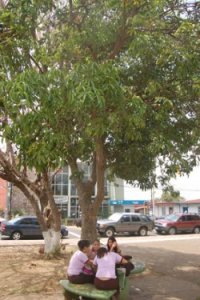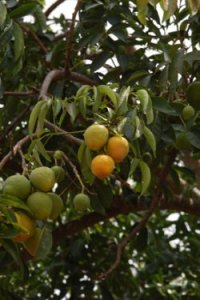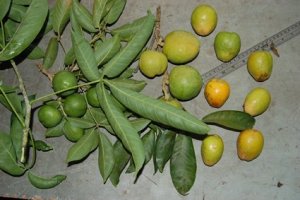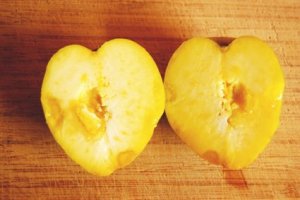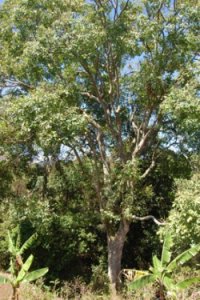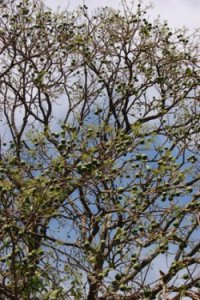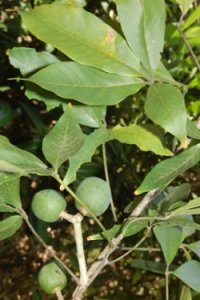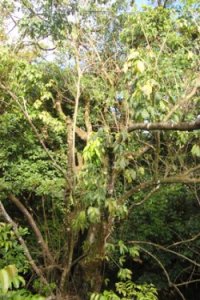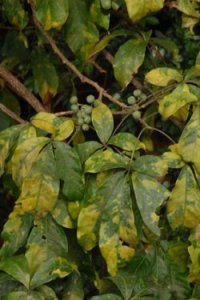 |
QUICK SEARCH
MO PROJECTS:
Africa
Asia/Pacific
Mesoamerica
North America
South America
General Taxonomy
Photo Essays
Training in Latin
America
MO RESEARCH:
Wm. L. Brown Center
Bryology
GIS
Graduate Studies
Research Experiences
for Undergraduates
Imaging Lab
Library
MBG Press
Publications
Climate Change
Catalog Fossil Plants
MO DATABASES:
W³MOST
Image Index
Rare Books
Angiosperm
Phylogeny
Res Botanica
All Databases
INFORMATION:
What's New?
People at MO
Visitor's Guide
Herbarium
Jobs & Fellowships
Symposium
Research Links
Site Map
Search
|
Draft Treatments | Guidelines | Checklist | Citing | Editors The Cutting EdgeVolume XVII, Number 2, April 2010News and Notes | Leaps and Bounds | Germane Literature | Season's Pick | Annotate your copy Casimiroa sapota Oerst. (Rutaceae), being heavy on our minds recently as we edit and revise the Manual Rutaceae treatment—and especially as this is the season its edible fruits are ripening for picking—is our choice for this quarter's photo essay.
These first four photos are from a plant in the central park of San Rafael de Heredia, vouchered by Hammel & Pérez 25560. In this individual the fruits are frequently seedless, and when seeds have been found, they are only one or two and very small (less than 1 cm). The fruit is very juicy and sweet, somewhat reminiscent of a peach, but not at all acidic. Toward the center, some of the flesh is whitish, but overall it is pale yellow or cream-colored.
The next three photos are from a large (ca. 25 m), wild individual not far from Hammel's house, along the Río Tures near San Francisco de San Isidro de Heredia (Hammel 25564). This plant is quite similar to the one from San Rafael, but has no ripe fruits yet, has just shed its leaves, and is sprouting new ones (10 April).
These last two photos are from another large, wild individual at the bridge over the Río Macarrón, just outside Barva de Heredia, on the road to San José de La Montaña (Hammel & Pérez 25559), not yet with ripe fruits. This individual is just like one planted in the courtyard of the Museo Nacional (not yet vouchered), in that the leaves are densely and notoriously pubescent. We are awaiting the ripening of fruits of all these to compare the color, flavor, and seeds to the ones in San Rafael. Several taxonomic and biological questions are associated with the Matasano (one of the common names applied to Casimiroa spp. in Mexico and Central America). The first problem is with the scientific name: our Manual treatment originally used the name C. edulis La Llave & Lex., with C. tetrameria Millsp.—the name used by Standley for Costa Rican plants in his Flora of Costa Rica—as a synonym. No mention was made of C. sapota, which, according to the Flora de Nicaragua, occurs in Nicaragua and in Costa Rica, and is distinct from the Mexican C. edulis. In this respect, Flora de Nicaragua follows the work of M. Martínez (Las Casimiroas de México y Centroamérica. Anales Inst. Biol. Univ. Nac. México, Bot. 22: 25–81. 1951). According to Martínez, C. tetramería is endemic to the region of Yucatán, Mexico, and only C. sapota has been collected in Costa Rica. The purported difference between C. edulis and C. sapota is the longer and thinner petioluoles of the former, even though Martínez gives no measurements for thickness and, over all forms and varieties, any difference in the stated length of petioluoles is nil. Nevertheless, the type of C. edulis is from Mexico and that of C. sapota is from Nicaragua, and based just on type images, the Costa Rican material does resemble more closely C. sapota. To finish this already too-long story: without a more thorough revision of the genus, we can do no better than follow Martínez and the Flora de Nicaragua in using the name C. sapota for the Costa Rican material. The other question of names involves the common name "Matasano," which translates directly to "kill healthy" or more freely, "that which kills the healthy," a rather ironic name for a plant that is sometimes cultivated and highly esteemed for its delicious fruits! However, this plant is also considered to have medicinal properties, aiding against insomnia and headaches, among others. Perhaps it is in that regard that "Matasano" is applied to this plant, at least one Spanish-English dictionary giving "quack," "charlatan" or "empiric" as coloquial english translations of "Matasanos." Neither of these curative results is evident from eating one or two fruits, the leaves and seeds being the source of any such presumed effects. Although this species is dioecious, no staminate plants are evident in the immediate vicinity of any of the four pistillate individuals here mentioned (a presumed staminate plant, however, does occur in Parque Nacional, only about two blocks from the Museo Nacional tree). The low or abortive seed production of the plant in the central park of San Rafael might indicate that fruits can develop without fertilization. |
||||||||||||||
© 1995-2025 Missouri Botanical Garden, All Rights Reserved
4344 Shaw Blvd.
St. Louis, MO 63110
(314) 577-5100
Technical Support
